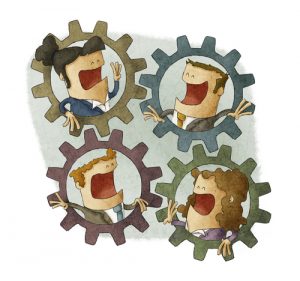If you want cohesive and successful teamwork, you need effective communication. Plain and simple.
For better or worse, most of us can remember those days of “picking teams.” Whether it was on the playground or in gym class, the fine art of choosing just the right players in order to win a competition has been practiced for centuries.
But it’s a whole different situation when you’re a grownup. It’s not only about athletic ability or popularity; it’s about appreciating strengths, working for common goals, and so much more. But one of the things that you absolutely must have for any team to be successful is cohesion, and strong cohesion begins with communication.
A study conducted by MIT’s Human Dynamics Laboratory about the science of building great teams showed that, “with remarkable consistency, the data confirmed that communication indeed plays a critical role in building successful teams.” So, the question is: how do you get there?
Begin with the End
The first thing every individual on your team must have is a clear vision of the finish line: what are your goals and what are you trying to achieve? If you’re looking for a few ways to get started, check out these options. Having clarity of purpose provides the drive, stamina, purpose and direction for individual team members.
And while there are numerous characteristics of successful teams that I’ve explored in other posts, one of the most important factors for team cohesion is communication, plain and simple.
Keys to Effective Team Communication
While effective communication is important in all aspects of your life, there are specific keys to cohesive teams that can make the difference between team wins or losses.
Welcome the ‘I’
While the popular phrase, “there is no ‘I’ in team,” is the common perspective, there is great value in the opposite. If everyone on the team feels a direct ownership to meeting the results of the team, there’s nothing that they cannot accomplish. Through their own actions and words, each person has an opportunity to demonstrate that they are 100% committed – that they’ll do whatever it takes.
And on an even deeper level, each person needs to understand themselves and know how to get the spiritual, physical and intellectual sides of their personality in alignment.
But Stress the ‘We’
Ultimately, ‘we’ should be the dominant language of the team. When ‘I’ is overused, or when credit or recognition is given to individuals instead of the group as a whole, it greatly undermines the collective mission.
When each member of the team understands who they are and that we are all connected, everyone works in harmony. Instead of competing with one another or wanting to get credit, team members genuinely support each other and remain focused on a common goal.
Cultivate Trust
Individuals must have the willingness to be real, raw and vulnerable. This means they must feel safe to admit when they need help or are confused about a task or project. Individuals must be willing to reach out and up for help.
Insist on Authenticity
Team leaders and members must be real and engage authentically. This means that egos are left at the door.
Listen to Understand
We all have a great desire to be understood. When we can listen from an open, curious and ego-free perspective (and resist the urge to respond to every single thing), we draw out the best that can be revealed for the team. Being open to how others see things – and truly gaining an understanding – can bring out the best in everyone.
Feel the Conflict
When individuals open up, trust and express themselves, at some point there will be conflict. So, teams must learn to be comfortable with the feeling of conflict and saying what they have to say anyway. That’s why having healthy guidelines and boundaries in place to deal with conflict is so important. Because ultimately, when conflict is seen as a healthy part of the process, members can move past it, knowing that at the end of the day relationships will still be strong.
Have Fun
Humor, fun and play are essential components of effective communication. So
always remember to embrace and promote fun, remembering to not exclude others (no inside jokes). Don’t take yourself too seriously, and welcome levity and opportunities to lighten the mood.
What do you think makes a cohesive team?
While I’ve shared some of the top communication factors that make teams cohesive, I’d love to know what you think. In your experience with either leading or being a part of teams, what are the keys to communication that work? And what doesn’t? Please share your feedback below.

